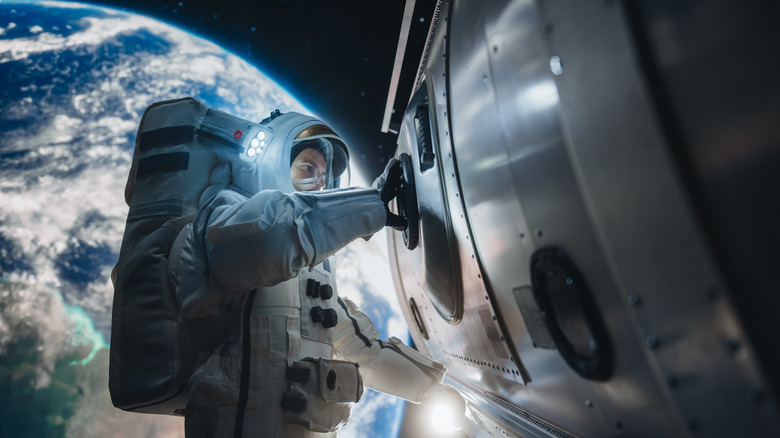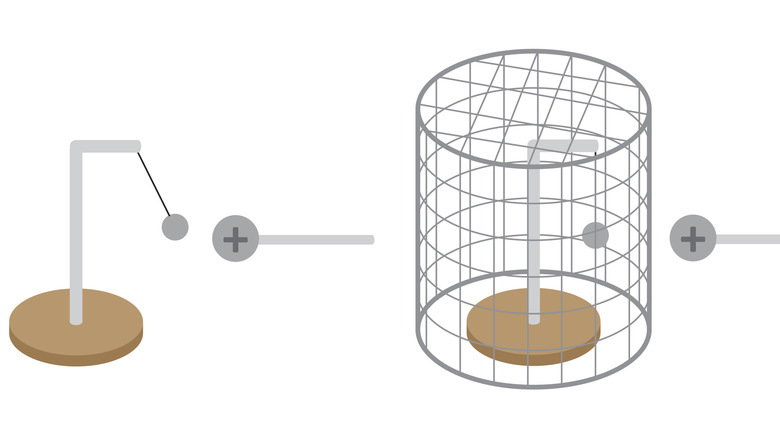
Gorodenkoff/Shutterstock
If you think the space race ended with the moon landing, it’s time for an update. Space travel is slowly growing from the ultra-exclusive purview of governments to the environment of the exploring capitalist. The commercial low-earth-orbit economy looks like one of the next great expansions of human activity.
Advertisement
Boeing, Space X, Blue Origin, Virgin Galactic, and dozens of other companies have collaborated with NASA to make spaceflight more affordable, potentially even profitable, and safer. The phrase «moon shot» may have been coined during the Space Race as an extraordinarily rare and challenging attempt at an incredible feat, but over a half-century later, space is growing more accessible.
The mission to establish a permanent presence in outer space has helped shepherd the next generation of exploration technology, and few pieces of astronaut equipment have captured the public’s imagination as a symbol of exploration quite like the spacesuit. Along with companies like Boeing, SpaceX is attempting to reimagine the possibilities of what a space suit can be. Let’s take a look at the evolution of the space suit, and dive into changes SpaceX is planning to implement with its own.
Advertisement
The spacesuit then and now

Dima Zel/Shutterstock
Formerly known within NASA as the Extravehicular Mobility Unit (EMU), a space suit allows astronauts to survive outside of a space vehicle. Not all astronauts get to use an EMU. Only about half of the 550 people who have gone to space have executed spacewalks or extravehicular activities (EVAs).
Advertisement
There are two primary classes of EVA: planned and unplanned. Planned EVAs tend to focus on repairing and maintaining the spacecraft (EVAs played a prominent role in the assembly of the International Space Station) or conducting mission support operations. Astronauts may perform Unplanned EVAs as issues arise.
SpaceX is one of many firms commercializing space activity. Earlier this month, a crew of four astronauts penetrated 700 kilometers into space to test Starlink’s space communication abilities, research the impact of space radiation on human health, and execute the first commercial spacewalk in history in hopes of testing the development of the SpaceX EMU.
Thousands of EMU suits will be required for a future in space, whether on the moon or beyond. SpaceX is also endeavoring to build one that will usher in the next generation of spaceflight with improved comfort, safety, and capability — not to mention affordability, given that a full NASA space suit can cost millions.
Advertisement
Let’s look at some of the most futuristic features the company is planning to implement.
Inflatable rigidity improves mobility

Peepo/Getty Images
Most previous generations of spacesuit designed by NASA have been very bulky, partially because engineers weren’t prioritizing comfort and ease of movement. That seems to be a priority for those rethinking next-generation suit designs.
Advertisement
SpaceX principal spacesuit engineer Erik Kraus calls it «like a suit of armor made of fabric.» The suit will protect wearers from all the intense environmental dangers of space while remaining comfortable and mobile. SpaceX based its EVA suit on its intra-vehicular (IVA) suit. The ultimate goal for these suits may not just be for astronauts, with an eye toward eventual mass production, so standardized features across SpaceX’s IVA and EVA suits will help reduce costs.
One crucial difference is that the soft portions of the EVA suit inflate to rigidity under pressure, using rotational joints to provide space for movement. Old EVA suits incorporated bulky, largely rigid structures. Material design and fabrication innovations have made the EVA suit slim and mobile enough to be worn during spacewalks, launches, and recovery. SpaceX is tight-lipped about its materials but admits that some come from constructing the Falcon rocket and Dragon spacecraft.
Advertisement
The SpaceX EVA suit’s slim appearance and modern design aren’t solely due to technological advances. NASA’s EMU was designed for long-term space walks lasting up to 8 hours. It also included propulsion, life support systems, and multiple insulation layers. SpaceX’s EVA suit is intended for shorter and less intense spacewalks. Think of NASA’s EMU as a submarine and SpaceX’s EVA suit as a drysuit diving rig.
3D-printed helmet and heads-up display
There is not always much time or opportunity to pop your helmet off, sit, and whip out your almanac to consult the weather in space. Astronauts have a lot on their minds, and SpaceX aims to simplify some things by providing a heads-up display in its suit helmets.
Advertisement
The helmet is a 3D-printed unit with a polycarbonate visor coated with indium tin oxide and copper to prevent fog and glare. A built-in camera and sensors monitor the astronaut’s status, including suit pressure, temperature, humidity levels, and time in space. While astronauts in older suits would have access to this information, it would require breaking concentration to glance at a wrist — an interruption that could disrupt a delicate operation. SpaceX’s new suit projects that information on a transparent screen within the helmet.
SpaceX envisions its current suit as one that will help to colonize the Moon and Mars. A version of this suit may protect you or a loved one from the ravages of space on a future vacation or business trip.
Advertisement
The visor

IrenaR/Shutterstock
Engineering materials to keep human beings safe in outer space is difficult enough without worrying about making them transparent. The visor of a spacesuit is crucial for protecting them from space radiation and keeping the astronaut sealed from the environment.
Advertisement
The long-term plan of commercial space exploration involves venturing beyond low-earth orbit, where astronauts face increased exposure to radiation. The visor, therefore, must perform a dual function, not only shielding the astronaut, but also ensuring clear visibility.
In the past, NASA used a translucent layer of gold to block ultraviolet light. SpaceX’s EVA suit visor is made of polycarbonate — a virtually unbreakable plastic with excellent optical qualities. The visor gets coated with copper and other materials to help keep the sun out of the eyes of the crew while reflecting infrared heat toward the crew when faced toward deep space.
Though relatively simple compared to some of the other features of the SpaceX EVA suit, the visor is a critical piece of safety equipment onboard the spacecraft.
Advertisement
Faraday cage

Patricia F Carvalho/Getty Images
Keeping healthy in outer space can be complex. SpaceX claims its astronauts will be able to worry less about one thing in its EVA suits: electromagnetic radiation. Apparently, its suits won’t have to worry about it either.
Advertisement
We mentioned earlier how space radiation could impede an astronaut’s ability to complete the mission. The same radiation can also damage the suit’s functionality. If an electromagnetic field strikes something that conducts electricity, like an EVA suit, the charges could travel inside and damage the electronic suite.
Engineers included a Faraday cage, sometimes known as a Faraday layer, in the design to protect the suit. It works like a lightning rod for a house, directing electricity from the roof to the ground without passing through the systems or appliances within the home. A Faraday cage intercepts electric fields and passes them through the cage harmlessly without damaging the suit.
Glancing at an EVA suit does not readily reveal the Faraday cage, but its inclusion indicates that SpaceX is serious about protecting its investment, and it seems like the private venture’s philosophy is working; recently, astronauts have been ditching Boeing’s spacesuits for SpaceX gear.
Advertisement